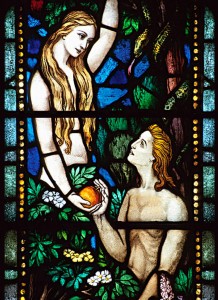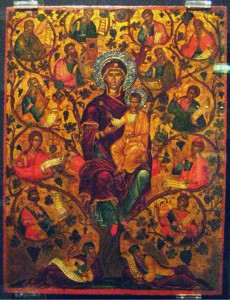[From the online Jesse Tree.]
A reading from the book of Genesis (3:1-8):
Now the serpent was more subtle than any other wild creature that the LORD God had made. He said to the woman, “Did God say, `You shall not eat of any tree of the garden’?” And the woman said to the serpent, “We may eat of the fruit of the trees of the garden; but God said, `You shall not eat of the fruit of the tree which is in the midst of the garden, neither shall you touch it, lest you die.'” But the serpent said to the woman, “You will not die. For God knows that when you eat of it your eyes will be opened, and you will be like God, knowing good and evil.” So when the woman saw that the tree was good for food, and that it was a delight to the eyes, and that the tree was to be desired to make one wise, she took of its fruit and ate; and she also gave some to her husband, and he ate. Then the eyes of both were opened, and they knew that they were naked; and they sewed fig leaves together and made themselves aprons. And they heard the sound of the LORD God walking in the garden in the cool of the day, and the man and his wife hid themselves from the presence of the LORD God among the trees of the garden.
When God made our first parents, he put them in the Garden of Eden, where they had everything they could want. The Garden provided food, warmth, and safety, and they could eat from the Tree of Life and never die. But the best thing about the Garden was that God lived their with our first parents. They could talk with him and walk with him there, the way you meet your best friend.
 To stay in the Garden, our first parents had really to be best friends with God. They had to trust that he knew what was right and wrong, good and bad, safe and harmful. But Satan told them a lie, the biggest lie there is: he told them that God did not really love them, and told them that God wanted to keep the best things away from them so he could have the best things all for himself. First Eve and then Adam believed the lie, stopped trusting God, and claimed the power to decide for themselves what is right and what is wrong. They preferred the fruit of the Tree of Knowledge of Good and Evil over being friends with God.
To stay in the Garden, our first parents had really to be best friends with God. They had to trust that he knew what was right and wrong, good and bad, safe and harmful. But Satan told them a lie, the biggest lie there is: he told them that God did not really love them, and told them that God wanted to keep the best things away from them so he could have the best things all for himself. First Eve and then Adam believed the lie, stopped trusting God, and claimed the power to decide for themselves what is right and what is wrong. They preferred the fruit of the Tree of Knowledge of Good and Evil over being friends with God.
When God came to visit them after that, Adam and Eve didn’t walk and talk with him. In fact, they hid from him. They were afraid of him! Right away, God saw that they could not live in the Garden anymore. He banished them, sent them away. The world became a sad place for Adam and Eve, a place where they would have to work hard to get their food, a place where they knew they would have to die someday, and a place where God seemed far away—not because he was far from them but because they were far from him.
Ever since that day, all boys and girls have been born into a world where people are hungry and where people have to die. Everyone has been born into Adam’s sin, and for thousands of years little boys and girls were born away from God’s friendship—away from the Garden of Eden. But the story of Advent is about how God came to find his lost people.




